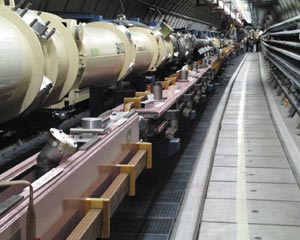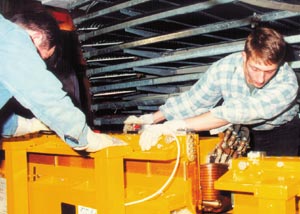
With only days to go before a scheduled long shutdown began on 3 March, the upgraded HERA collider – HERA II – succeeded in running with high-energy longitudinally polarized positrons at three interaction regions, soon reaching a polarization of 50%. This is a first not only for DESY, the laboratory that is home to HERA, but also for the world.
Electron and positron beams in storage rings have a natural tendency to become polarized with the spins of the particles perpendicular to the direction in which the beam is travelling. However, in 1994 HERA made polarization history when spin rotators were used to convert this vertical polarization to a longitudinal polarization, with the spins oriented along the particles’ direction of motion. This enabled the HERMES experiment in particular, which directs the polarized beam at a gas target, to begin its measurements of collisions between protons and polarized electrons in order to investigate the origin of the spin in the proton – something that is still not well understood.

With the HERA upgrade in 2000/2001, spin rotators were also installed at the collision regions where the H1 and ZEUS experiments are located. The removal of compensating solenoids in these regions and the use of stronger quadrupoles for focusing in the arcs of the collider made the conditions for polarization of the positron beam more difficult in HERA II. However, on 24 February, longitudinal polarization was achieved at the three interaction regions where pairs of spin rotators are now installed.
The machine ran for many hours, with the pairs of rotators flipping the spins along the beam direction before the interaction regions and back again as the beam emerged from the detectors, 47,000 times a second. Initially, the solenoid magnets of H1 and ZEUS remained off, but on 2 March, the day before the shutdown, the solenoids were switched on and a polarization of 50% was achieved for collisions in the detectors.
Shortly before the shutdown, the machine crew was also able to achieve a peak luminosity of 2.7 x 1031 cm-2 s-1 for the first time, exceeding the maximum luminosity achieved by HERA I. This indicates that the four-fold increase in luminosity expected with HERA II is in fact achievable, and this will be a major goal when the machine restarts after the 18-week shutdown. During this time, work will take place on the vacuum system and on some parts of the H1 and ZEUS detectors. Systematic tests by the experiments and machine crew have revealed the source of the high background rates that unexpectedly caused problems after the machine and detector upgrades, and which made data-taking in the two experiments extremely difficult. The aim will be to reduce these high background rates, so that HERA II can begin to perform as planned.







